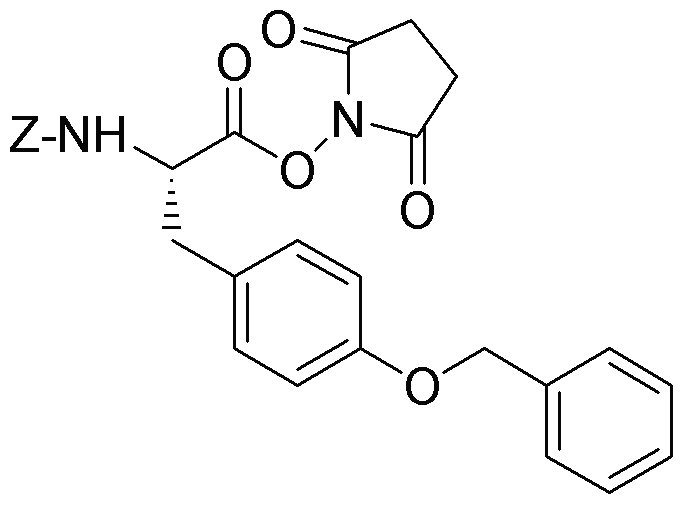Z-O-benzyl-L-tyrosine N-hydroxysuccinimide ester is widely utilized in research focused on:
- Peptide Synthesis: This compound serves as a key building block in the synthesis of peptides, allowing researchers to create complex molecules for drug development and biological studies.
- Drug Delivery Systems: Its ability to form stable conjugates makes it valuable in designing drug delivery systems, enhancing the bioavailability of therapeutic agents.
- Bioconjugation: It is commonly used in bioconjugation techniques, enabling the attachment of biomolecules to surfaces or other molecules, which is essential in diagnostic applications.
- Research in Neuroscience: The compound's structural properties make it useful in studying neurotransmitter pathways and developing potential treatments for neurological disorders.
- Antibody Labeling: This ester is effective in labeling antibodies for immunological assays, improving the sensitivity and specificity of detection methods.
General Information
Properties
Safety and Regulations
Applications
Z-O-benzyl-L-tyrosine N-hydroxysuccinimide ester is widely utilized in research focused on:
- Peptide Synthesis: This compound serves as a key building block in the synthesis of peptides, allowing researchers to create complex molecules for drug development and biological studies.
- Drug Delivery Systems: Its ability to form stable conjugates makes it valuable in designing drug delivery systems, enhancing the bioavailability of therapeutic agents.
- Bioconjugation: It is commonly used in bioconjugation techniques, enabling the attachment of biomolecules to surfaces or other molecules, which is essential in diagnostic applications.
- Research in Neuroscience: The compound's structural properties make it useful in studying neurotransmitter pathways and developing potential treatments for neurological disorders.
- Antibody Labeling: This ester is effective in labeling antibodies for immunological assays, improving the sensitivity and specificity of detection methods.
Documents
Safety Data Sheets (SDS)
The SDS provides comprehensive safety information on handling, storage, and disposal of the product.
Product Specification (PS)
The PS provides a comprehensive breakdown of the product’s properties, including chemical composition, physical state, purity, and storage requirements. It also details acceptable quality ranges and the product's intended applications.
Certificates of Analysis (COA)
Search for Certificates of Analysis (COA) by entering the products Lot Number. Lot and Batch Numbers can be found on a product’s label following the words ‘Lot’ or ‘Batch’.
Numéro de catalogue
Numéro de lot/série
Certificates Of Origin (COO)
This COO confirms the country where the product was manufactured, and also details the materials and components used in it and whether it is derived from natural, synthetic, or other specific sources. This certificate may be required for customs, trade, and regulatory compliance.
Numéro de catalogue
Numéro de lot/série
Safety Data Sheets (SDS)
The SDS provides comprehensive safety information on handling, storage, and disposal of the product.
DownloadProduct Specification (PS)
The PS provides a comprehensive breakdown of the product’s properties, including chemical composition, physical state, purity, and storage requirements. It also details acceptable quality ranges and the product's intended applications.
DownloadCertificates of Analysis (COA)
Search for Certificates of Analysis (COA) by entering the products Lot Number. Lot and Batch Numbers can be found on a product’s label following the words ‘Lot’ or ‘Batch’.
Numéro de catalogue
Numéro de lot/série
Certificates Of Origin (COO)
This COO confirms the country where the product was manufactured, and also details the materials and components used in it and whether it is derived from natural, synthetic, or other specific sources. This certificate may be required for customs, trade, and regulatory compliance.


